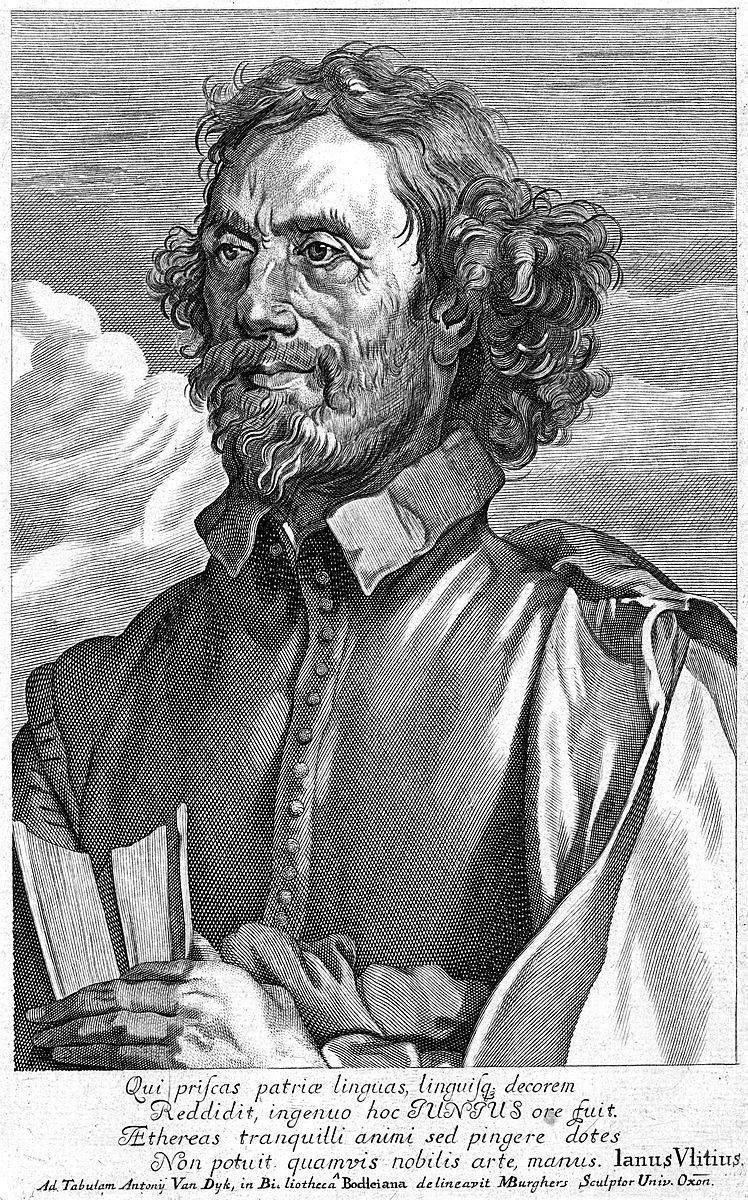Name Franciscus Junius Role The younger | Parents Franciscus Junius | |
 | ||
Died 1677, Windsor, United Kingdom Books De pictura veterum libri tres Similar People Albert - Prince Consort, William IV of the United Ki, Mary of Teck | ||
Colloquium franciscus junius and the development of the reformed tradition
Franciscus Junius (29 January 1591 – 1677),[1] also known as François du Jon, was a pioneer of Germanic philology. As a collector of ancient manuscripts, he published the first modern editions of a number of important texts. In addition, he wrote the first comprehensive overview of ancient writings on the visual arts, which became a cornerstone of classical art theories throughout Europe.
Contents
Life
Junius was born in Heidelberg. He was brought up at Leiden, Netherlands as his father, also called Franciscus Junius, was appointed professor of Hebrew at Leiden University in 1592. In 1602 his parents died, and Junius went to live with his future brother-in-law, the humanist scholar Gerhard Johann Vossius in Dordrecht. He studied theology at Leiden and Middelburg.
In 1617, he became a pastor at Hillegersberg, near Rotterdam. He resigned this position the following year, after he refused to take sides in a theological conflict in the Dutch Reformed Church, centering on faith out of free will as advocated by Jacobus Arminius or faith out of predestination, as defended by Junius' uncle Franciscus Gomarus. After his resignation, Junius elected to travel instead: he visited first France, and then moved to England, where in 1620 he was employed by Thomas Howard, earl of Arundel, as a tutor to his son, and later as librarian. It was for Arundel, an avid collector of Greek and Roman art objects, that Junius wrote his De pictura veterum, a theoretical discussion of classical art and one of the cornerstones of the Neoclassical movement. Published in 1637 in Latin, it was followed by his own translations into English (1638) and Dutch (1641); the latter edition was written with a readership of artists in mind.
Junius remained resident in England for more than twenty years, but upon the revolt against Charles I in 1642, he joined the Earl and his wife to the Low Countries. Soon after his return in Holland, Junius became interested in the history of the Dutch language, an interest that quickly spread to the oldest phases of other Germanic languages. As a result, he published a commentary on an Old High German paraphrase of the Song of Songs, the first edition of a collection of Old English poems, and the first edition, together with an extensive dictionary, of the Gothic Gospels. Upon his death a number of lexicographical works remained unpublished, of which an English etymological dictionary was published posthumously.
Junius was the owner of an important piece of Christian literature called the MS Junius 11 codex, also known as the "Cædmon manuscript", or "Junius" codex. Junius was a close acquaintance of John Milton. It has been suggested that similarities between Milton's Paradise Lost and parts of the "Genesis" material in MS Junius 11, are the result of Milton having consulted MS Junius 11 via Junius, though this hypothesis cannot be proven.
The first mention of the Heliand in modern times occurred when Junius found a fragment in 1587.
Junius was the first person to substantially study the Codex Argenteus (or Gothic Bible). He first showed an interest in Gothic in 1654, and engaged in a study of the Codex Argenteus in 1654. Isaac Vossius entrusted the codex to Junius. Vossius had secured the codex from Queen Christina as part of a debt settlement. MS Junius 55 is a transcript Junius made of the full text of the original manuscript. Junius engaged Jan van Vliet in his study of Gothic.
The earliest extant reference to the first foliation of the Nowell Codex (British Library MS Cotton Vitellius A.xv), which contains the poem Beowulf, was made sometime between 1628 and 1650 by Junius.
In 1675, Junius returned to Oxford and died in November 1677 at the house of his nephew Isaac Vossius in Windsor, Berkshire; he was buried there at St George's Chapel. In his life he had amassed a large collection of ancient manuscripts, and in his will he bequeathed these to the Bodleian Library at the University of Oxford. Amongst the works included in this bequest were a major manuscript of Anglo-Saxon poetry, commonly known as the Junius manuscript after him, and the unique manuscript of the Ormulum.
Works
In his later life, Junius devoted himself to the study of the Old Germanic languages. His work, while intrinsically valuable, is particularly important as having aroused interest in a subject that at the time was often neglected.
Major works include:
